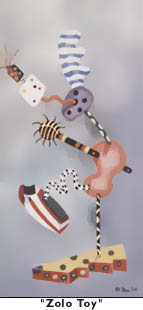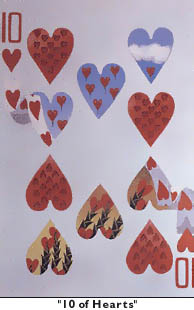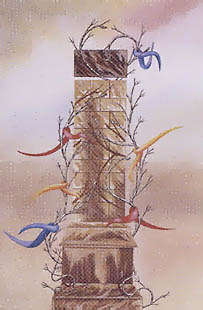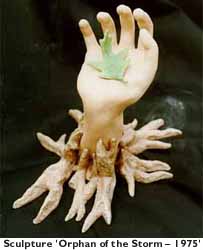Seeing pictures in the paint
From imagination to surrealism
By Daniel Shearer
Princeton Packet Staff Writer
Thursday, March 18, 1999
More than 20 years ago, Newtown, Pa., resident and painter Stephen Polin began wrestling with a particular painting.
 He had been enchanted early in his artistic career by the surrealist works of Salvador Dali and Max Ernst, and strove for years to perfect a nearly brushless style of oil painting, but around 1975 he wanted to try something different. He spread a thick layer of white acrylic paint, called jesso, over a canvas and while it was still wet, sandwiched it against another canvas. Then he pulled the two surfaces apart, creating a rippled surface that he allowed to dry. He had been enchanted early in his artistic career by the surrealist works of Salvador Dali and Max Ernst, and strove for years to perfect a nearly brushless style of oil painting, but around 1975 he wanted to try something different. He spread a thick layer of white acrylic paint, called jesso, over a canvas and while it was still wet, sandwiched it against another canvas. Then he pulled the two surfaces apart, creating a rippled surface that he allowed to dry.
For hours, he sat in front of the odd patterns, searching for recognizable images in the shapes — endless tedium. With oils he brought the surface alive. Days stretched into months, but he returned to the canvas over and over to try and find the images in it. Other paintings took shape under his brush during this time, but he was strangely drawn back to the work, which he later titled "Harlequin Havoc."
 "In 1998, when I decided I was going to finish this, I noticed that every time I was working on this, I was having a lot of problems in my life," says Mr. Polin, whose exhibit, Now and Then, is on display at the New Jersey State Museum's Cafe Gallery in Trenton through April 11. "Turmoil and disruptions. And I figured, maybe if I finish this, that'll end. When I finished the painting, it didn't end, but I worked really hard trying to get all these images. If you look at it, you'll notice all kinds of hearts and clubs and spades. Everybody sees something different." "In 1998, when I decided I was going to finish this, I noticed that every time I was working on this, I was having a lot of problems in my life," says Mr. Polin, whose exhibit, Now and Then, is on display at the New Jersey State Museum's Cafe Gallery in Trenton through April 11. "Turmoil and disruptions. And I figured, maybe if I finish this, that'll end. When I finished the painting, it didn't end, but I worked really hard trying to get all these images. If you look at it, you'll notice all kinds of hearts and clubs and spades. Everybody sees something different."
He steps up to the work, one of about 30 oil paintings at the exhibit, putting his head inches away from the canvas.
"Lean in here," he says. "You can see the iridescence if you catch the light right. In order to get that coloration in here, I pulverized about $80 worth of pearls and then I mixed it in with my paint so that I get this effect.
 "Later, I found out they sell an iridescent paint which was very close in effect to this, which would have been a lot easier, but I didn't know that at the time." "Later, I found out they sell an iridescent paint which was very close in effect to this, which would have been a lot easier, but I didn't know that at the time."
"Harlequin Havoc" was the first of several paintings he did using the technique, but since then, he's chosen to abandon the style.
"It was too tedious and it didn't end the turmoil in my life," he says.
Now 51, he has painted 261 oils in a variety of styles. The exhibit includes a number of his surreal works, among them, "Eve" — an abstract female form in a desert, with an apple and a serpent nearby — as well as several more impressionistic works.
 "I usually never go back into a painting, but when 'Eve' was complete, somebody came to me and was looking at it, and I didn't have a bite out of the apple," he says. "And they said, 'Well, where's the bite, because the serpent didn't lose his legs until after the bite,' so I put it in. And then you get this shadow here, sort of looks like a breast, and some very phallic images, but that was not planned that way." "I usually never go back into a painting, but when 'Eve' was complete, somebody came to me and was looking at it, and I didn't have a bite out of the apple," he says. "And they said, 'Well, where's the bite, because the serpent didn't lose his legs until after the bite,' so I put it in. And then you get this shadow here, sort of looks like a breast, and some very phallic images, but that was not planned that way."
Mr. Polin paints many of his works on tempered masonite, a hard, smooth surface which allows him to produce works with barely visible brush marks.
"I like a smooth surface," he says. "And a hard surface is good because it gives you resistance. I like the tangible aspect of it. When you're working with something hard like masonite, it really feels good coming through that brush."
Even when he paints on canvas, he makes a painstaking effort to make the surface as smooth as possible, preparing it with several layers of acrylic paint, which he then sands down to prepare a surface for oil paints.
 "I like it when the paint looks almost like it has been impregnated into the surface," he says. "I like it when the paint looks almost like it has been impregnated into the surface," he says.
Over the years, Mr. Polin has had numerous solo exhibitions in New York and London, including his first major exhibit in 1975 at the Bodley Gallery in New York. David Mann, who previously represented Paul Klee, Pablo Picasso and Max Ernst, offered Mr. Polin a two-week show. In addition to his oil work, he has also begun sculpting in stone and aluminum, and painting with acrylics and watercolors.
"A lot of what I'm doing now is automatic," he says. "I will literally create a smear on the canvas of paint, let it dry and then look for pictures that are in there, and then detail it to find them.
"It's kind of hard to explain the paintings. Everybody sees something different. I always sort of give them a title and let them stand on their own with the title. Somebody once asked me to explain what one of the paintings meant and I said, 'You know, if I could tell you in words what I was trying to express in paint, I'd be writing stories instead of painting.' "
Now and Then, artwork by Stephen Polin, will be on display at the New Jersey State Museum's Cafe Gallery, 205 West State St., Trenton, through April 11. Admission is free. Museum hours: Tues.-Sat., 9 a.m.-4:45 p.m.; Sun., noon-5 p.m. For more information, call (609) 292-6464. Also, check out Mr. Polin on the Internet at http://www.spxyxx.com/.
|
 |